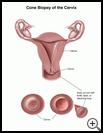
Cone Biopsy of the Cervix
________________________________________________________________________
KEY POINTS
- Cone biopsy of the cervix is a procedure for removing abnormal tissue from the cervix, which is the lower part of the uterus that opens into the vagina.
- Follow any other instructions your healthcare provider gives you, and ask any questions you have before the procedure.
- Ask your healthcare provider how and when you will get your test results and how to take care of yourself at home.
________________________________________________________________________
What is a cone biopsy of the cervix?
Cone biopsy of the cervix is a procedure for removing abnormal tissue from the cervix. The cervix is the lower part of the uterus that opens into the vagina. The uterus is the muscular organ at the top of the vagina. Babies grow in the uterus, and menstrual blood comes from the uterus, through the cervix.
When is it used?
This procedure is done to:
- Remove cells from your cervix to help make a diagnosis
- Remove abnormal, precancerous, or cancerous cells from your cervix
- Treat chronic cervicitis (inflammation of the cervix)
- Check the results of other tests
Ask your healthcare provider about your choices for treatment and the risks.
How do I prepare for this procedure?
- Make plans for your care and recovery after you have the procedure. Find someone to give you a ride home after the procedure. Allow for time to rest and try to find other people to help with your day-to-day tasks while you recover.
- You may or may not need to take your regular medicines the day of the procedure. Tell your healthcare provider about all medicines and supplements that you take. Some products may increase your risk of side effects. Ask your healthcare provider if you need to avoid taking any medicine or supplements before the procedure.
- Tell your healthcare provider if you have any food, medicine, or other allergies such as latex.
- Follow your provider's instructions about not smoking before and after the procedure. Smokers may have more breathing problems during the procedure and heal more slowly. It’s best to quit 6 to 8 weeks before surgery.
- Your healthcare provider will tell you when to stop eating and drinking before the procedure. This helps to keep you from vomiting during the procedure.
- Follow any other instructions your healthcare provider gives you.
- Ask any questions you have before the procedure. You should understand what your healthcare provider is going to do. You have the right to make decisions about your healthcare and to give permission for any tests or procedures.
What happens during the procedure?
You will be given a local, regional, or general anesthetic to keep you from feeling pain. If you have local or regional anesthesia, you may also be given medicine to help you relax.
Your healthcare provider will put a chemical on your cervix that makes it easier to see abnormal tissue. Your healthcare provider will remove the abnormal tissue. The tissue will be sent to the lab for tests.
What happens after the procedure?
After the procedure, you may stay in a recovery area for at least a few hours or overnight, depending on what was done during the procedure.
You may have a little cramping after the procedure. You may also have some minor bleeding or spotting the first day or so after the procedure. For about 2 weeks, you may have a brownish discharge from the vagina. This is a normal part of the healing of your cervix. Your cervix should heal completely within a month.
Ask your healthcare provider:
- How and when you will get your test results
- How long it will take to recover
- If there are activities you should avoid and when you can return to your normal activities
- How to take care of yourself at home
- What symptoms or problems you should watch for and what to do if you have them
Make sure you know when you should come back for a checkup. Keep all appointments for provider visits or tests.
What are the risks of this procedure?
Every procedure or treatment has risks. Some possible risks of this procedure include:
- You may have problems with anesthesia.
- You may have infection, bleeding, or blood clots.
- Other parts of your body may be injured during the surgery.
- If a lot of tissue is removed, you may have a miscarriage if you get pregnant.
- If you have cancerous or precancerous cells and your healthcare provider removes too little tissue, some of the abnormal cells may remain.
Ask your healthcare provider how the risks apply to you. Be sure to discuss any other questions or concerns that you may have.

